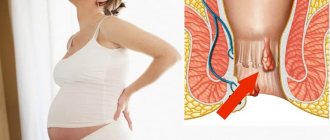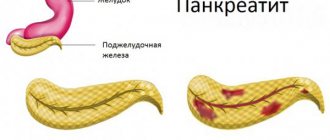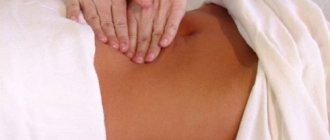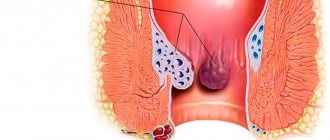Pain is the most painful symptom of hemorrhoids, which can occur only during bowel movements or be present constantly. If patients still put up with discomfort in the anus, the pain forces them to look for ways to solve the problem.
Some patients go straight to a proctologist, while others try to find relief in traditional medicine. But, unfortunately, the latter option does not always give the expected result, and sometimes is harmful to health. Therefore, in this topic we want to tell you how to relieve pain from hemorrhoids quickly and effectively, and most importantly safely. But first, we will look at what causes pain with hemorrhoids.
Pain is the most unpleasant symptom of hemorrhoids
The pain can be aching, acute throbbing, and also radiate to the back, tailbone and abdomen. Painful sensations with hemorrhoids can also be either periodic or permanent. When pain becomes constant, not only the patient’s physical condition suffers, but also his mental condition.
Life with pain loses its joyful colors, ability to work and sleep are disrupted. Therefore, a person faced with hemorrhoids is haunted by thoughts of how to get rid of the pain and ease his suffering.
Very often, patients are afraid of defecation due to pain, so they suppress the urge to have a bowel movement or go hungry. But this only makes the problem worse because the stool hardens and irritates the anus even more.
The severity and nature of pain in patients with hemorrhoids is influenced by the following factors:
- stage of hemorrhoidal disease (the most severe hemorrhoids of the fourth stage);
- type of complication of hemorrhoids (anal tears, thrombosis, strangulation or necrosis of the hemorrhoid, paraproctitis, etc.);
- patient's pain sensitivity.
The most severe pain occurs when touching the prolapsed internal and external nodes, which can happen when sitting on a hard chair or wearing tight underwear or clothes. Therefore, to reduce pain, you need not only to take painkillers for hemorrhoids, but also to choose the right chair, comfortable underwear, clothes and even sleeping position. It is also important to follow a diet and give up bad habits.
Causes of pain with hemorrhoids
The anorectal area has a very large number of pain receptors, which are located on the surface of the rectal canal and anal ring. Such a rich innervation of this zone explains why hemorrhoids hurt so much.
Irritation of nerve endings can be caused by the following factors:
- damage to the epithelium of the anal zone and the mucous membrane of the rectal canal, which most often occurs during defecation, especially if the feces are too hard;
- inflammation of the tissues of the anus.
Chronic hemorrhoids often lead to tears in the anal ring, the formation of ulcers and erosions on the skin in the anus, which becomes the main cause of pain.
What are the causes of acute hemorrhoids?
The development of an acute attack of hemorrhoids is based on two main reasons, or rather pathological processes - pinching of a prolapsed internal hemorrhoid in the anal ring and anorectal thrombosis. Let's talk about this in more detail.
Pinching of hemorrhoids
Internal hemorrhoids are a disease of the anus, which is characterized by varicose changes in the vessels of the submucous membrane of the rectum, which are located above the dentate line.
In the initial stages, the pathological process is asymptomatic, since the nodules are small and are constantly located inside the anal canal. But, starting from the second stage of hemorrhoids, varicose veins of the rectum begin to sag through the anal ring. At first, this happens only during bowel movements, and over time, when sneezing, coughing, laughing, etc.
The nodules that fall out irritate the anal ring, resulting in muscle spasm. Spasmed muscles of the anal valve compress the vessels supplying the nodes, which leads to poor circulation, swelling and increased pain.
Illiterate and untimely treatment of acute hemorrhoids is fraught with the development of anorectal thrombosis, since blood stagnates in the pinched lump, which thickens over time. In addition, prolonged pinching of a lump in the anal valve threatens the necrosis of its tissues, which requires only surgical treatment.
Thrombosis of hemorrhoids
Anorectal thrombosis (thrombosis of hemorrhoids) is a complication of hemorrhoids, which is based on the formation of a blood clot inside a varicose vein of the rectum. This complication can develop with both external and rectal hemorrhoids.
The blood clot that has formed inside the node puts pressure on its walls and irritates pain receptors, so the patient feels severe pain in the anus. Moreover, the pain syndrome is quite difficult to relieve and this can only be done after the blood clot has been eliminated.
Pain in the anus with anorectal thrombosis is constant. Defecation provokes increased pain, so patients specifically suppress the urge to bowel movement. But this does not alleviate the condition, but only aggravates it, because such a disservice leads to constipation.
How do different stages of hemorrhoids hurt?
The development of hemorrhoids is usually divided into four stages. This classification is based on the severity of symptoms and the presence of prolapse of hemorrhoids from the anus.
The first stage of hemorrhoids is considered the initial and easiest, since patients do not experience severe pain. The painful sensations are more like a certain discomfort in the rectum, which only bothers you during bowel movements and then only if it is difficult due to constipation. In addition, many patients may not even pay attention to such manifestations of the disease.
The second stage of hemorrhoids is characterized by more severe symptoms, as the hemorrhoids increase in size and begin to fall out during bowel movements. All this contributes to an increase in pain.
Acute pain with hemorrhoids at this stage can also be combined with feelings of burning, pressure and itching in the rectal canal, and if hemorrhoidal bleeding occurs, pulsation. Some patients complain of aching pain in the lower back, tailbone and lower abdomen.
The third and fourth stages of hemorrhoids are advanced and are characterized by severe pain, especially with the development of complications such as thrombosis, strangulation and necrosis of hemorrhoids.
Hemorrhoids fall out not only during bowel movements, but even with minor physical stress - sneezing, coughing, laughing, lifting weights, deep squats. If at the third stage the hemorrhoidal node can still be pushed back into place manually, then at the fourth stage this will not be possible, since it will fall back out.
Severe pain with hemorrhoids already becomes permanent, disturbing the patient even at rest. In addition, prolapsed nodes and weeping discharge from the anus contribute to irritation and inflammation of the skin of the anorectal area, the formation of erosions and ulcers, which is also accompanied by pain.
In severe cases, severe hemorrhoids can be complicated by paraproctitis, which gives intense throbbing pain. Thrombosis and necrosis of hemorrhoids is characterized by very severe pain that the patient is unable to tolerate.
How does exacerbation of hemorrhoids manifest?
The main symptom of acute hemorrhoids is pain in the anus, and the pain is pulsating and jerking in nature, and also increases with movements, bowel movements, coughing, sneezing, sitting on a hard surface and even in a lying position.
Patients may also complain of the following:
- itching and burning in the anus;
- discharge of blood from the rectum during bowel movements;
- general weakness;
- increased body temperature;
- nausea;
- pain in the lower abdomen, tailbone and lower back.
In addition, a mandatory sign of an acute attack of hemorrhoids is the presence of an external and prolapsed internal node in the anus.
Symptoms of acute external hemorrhoids
An external hemorrhoid is clearly visible to the naked eye because it is located near the anal ring. The external nodules are covered with skin and look like a round, painful lump with a bluish tint. Such bumps are characterized by severe swelling and inflammation, which can spread to adjacent tissues.
Symptoms of internal acute hemorrhoids
Internal hemorrhoids can be seen independently only after they begin to fall out, and this is the second stage of the disease.
The internal nodules that have fallen out also hurt a lot and have signs of inflammation. Such bumps differ from external hemorrhoids in that they are covered with the rectal mucosa, and not with skin.
Which doctor will help if hemorrhoids hurt a lot?
Hemorrhoids hurt, what should I do? In this case, the most correct thing would be to seek help from a specialist - a proctologist. In district clinics, a surgeon is involved in the treatment and diagnosis of this disease.
Only a specialist knows how to relieve pain from hemorrhoids. Treatment of this unpleasant disease is not only about pain relief. After all, in order to get rid of hemorrhoids and avoid their return, you need to carry out complex anti-hemorrhoidal therapy, which combines diet, lifestyle correction, the use of medications, and, if necessary, surgical intervention.
Surgery
Surgical intervention is used only in exceptional cases for acute hemorrhoids. First, the painful symptoms of the disease are eliminated with the help of medications. And only then can radical treatment methods be used.
Surgical removal of hemorrhoids is indicated if thrombosis of hemorrhoids is observed within 48 to 72 hours. In this case, the thrombosed node is large, and the inflammatory process spreads to the distal intestine and perianal area.
During surgery, a blood clot is removed (thrombectomy) from the hemorrhoidal node or the entire node is completely removed (hemorrhoidectomy).
If the acute phase of the disease lasts more than 72 hours, then conservative treatment is first prescribed. It is recommended to eliminate pain and inflammation, and then surgery is planned.
THERE ARE CONTRAINDICATIONS CONSULTATION WITH YOUR DOCTOR IS REQUIRED
Author of the article Alexey Alexandrovich Egorov, proctologist
Write your opinion
Pain from hemorrhoids: how to relieve with medications?
Drug treatment of hemorrhoidal pain involves the use of systemic drugs and local medications - suppositories, ointment, cream or gel, which contain an anesthetic. Your proctologist will tell you what is the best way to relieve pain and what medications to choose for this, since each medication has side effects and contraindications.
Painkillers for hemorrhoids
Painkillers will help relieve pain in the anus, but these medications do not affect the cause and pathogenesis of hemorrhoids, therefore they are only a symptomatic remedy.
For pain relief, non-steroidal anti-inflammatory drugs are most often used, among which the most effective are the following:
- Voltaren;
- Nimesil;
- Analgin;
- Nurofen.
Patients are also required to be prescribed venotonics and angioprotectors, since these drugs normalize the tone of the cavernous veins of the rectum, reduce the permeability of the vascular wall and help normalize blood circulation in the anorectal area. Thus, venotonics and angioprotectors eliminate the cause of hemorrhoids and, accordingly, pain.
The drugs of choice for hemorrhoids may be:
- Detralex;
- Troxevasin;
- Phlebodia 600;
- Venarus;
- Escusan and others.
Pain relieving ointments for hemorrhoids
For local therapy for pain in the anus, an ointment for hemorrhoids is excellent, which produces an anesthetic effect on the inflamed tissue. The ointment allows you to instantly relieve pain, as well as itching and burning.
You can relieve pain from hemorrhoids with the following ointments:
- Relief Advance. Contains benzocaine, which is a local anesthetic. The drug is applied to the tissue of the anus 4 times a day until the pain subsides. If necessary, Relief Advance can be used to relieve pain from hemorrhoids in women during pregnancy;
- Heparin ointment. In addition to heparin, the drug contains an anesthesin, which can effectively relieve pain in the anus. Depending on the intensity of the pain syndrome, the ointment is applied from one to three times a day;
- Proctosan. This painkiller consists of bufexamac, lidocaine, bismuth and titanium compounds. The first two components have analgesic properties. Proctosan is applied to external hemorrhoids or injected into the anus twice a day;
- Aurobin. The ointment contains prednisolone, lidocaine and D-panthenol. The action of all components is aimed at bringing a relief effect to the patient. The drug is applied to external hemorrhoids or injected into the rectal canal 2-4 times a day for 5-7 days.
Suppositories for pain relief for hemorrhoids
If internal hemorrhoids hurt, then in this case suppositories with anesthetics will be most effective.
have an excellent pain-relieving effect :
- Anestezol. The drug consists of benzocaine, lidocaine, menthol and bismuth compounds. Anestezol instantly relieves painful, severe hemorrhoids. If pain occurs, administer one suppository twice a day until relief occurs.
- Procto-Glivenol. This drug has a complex effect, since it contains both the anesthetic lidocaine and the venotonic drug tribenozide. Thanks to this composition, Procto-Glivenol relieves pain and also normalizes blood circulation in the anus. The drug is used 1 suppository 2 times a day;
- Anuzol. The drug contains belladonna extract, xeroform, as well as zinc compounds, which eliminates pain, dries out weeping wounds and accelerates their healing. The drug is prescribed 1 suppository 2-3 times a day;
- Proctosedyl M. These rectal capsules consist of benzocaine, butamben, hydrocortisone and framycetin. The first two ingredients are local anesthetics, resulting in a double analgesic effect. In case of severe pain, use one suppository twice a day, after the pain subsides - 1 suppository once a day. The duration of treatment should not exceed one week;
- Olestesin. This drug contains benzocaine and sea buckthorn oil. Olestezin suppositories have analgesic, anti-inflammatory and restorative effects. For severe pain, use one suppository three times a day.
Pain from hemorrhoids: how to relieve it with folk remedies?
If you have hemorrhoids, but circumstances do not allow you to turn to a specialist for help, and you don’t have a single painkiller at home, then you can use folk remedies.
Hemorrhoids can be relieved at home using lotions, baths or compresses. Let's look at how to do this.
Compresses
Compresses with ice or potatoes are excellent for relieving pain in the anus due to hemorrhoids:
- Ice cubes are placed in a plastic bag and wrapped in a soft cloth, after which a similar compress is placed on the anus. The procedure is carried out no longer than 15 minutes 5-6 times a day;
- raw potatoes should be placed in the refrigerator for one hour. After this, the vegetable is peeled and grated on a fine grater. The resulting mass is spread on a piece of gauze, folded in 4-5 layers, and applied to the sore spot for 15 minutes. Apply a compress with potatoes 5-6 times a day.
Lotions
Cool decoctions and infusions of medicinal plants are best suited for lotions, namely: chamomile, yarrow, calendula, oak bark, nettle, kidney herb and others.
A piece of gauze is soaked in a decoction of herbs and applied to the anus for several minutes. The procedure is repeated until the pain goes away.
You can also use the juice of aloe, potato, celandine and other plants for lotions.
Lotions with decoctions of medicinal plants relieve spasm of the anal sphincter, reduce swelling and inflammation, and thereby relieve pain.
Baths
The same folk remedies are suitable for baths as for lotions. You just need to know that for bleeding hemorrhoids with pain, you can only take cold water. Also, when taking cold baths, you need to be careful not to catch a cold. To do this, only the anus is immersed in water, and the genitals are covered with the hand.
In addition to decoctions and infusions of medicinal plants, you can use a solution of mumiyo, sea salt and potassium permanganate for baths.
Folk recipes
You can relieve pain from hemorrhoids using traditional medicine:
- Rowan. Take the berries of the plant and mash until they form a paste. The resulting folk medicine is placed in gauze and used as a compress for external hemorrhoids.
- Special enemas. The solution is made from chamomile. Take 2 tablespoons of dried plant flowers and pour a glass of boiling water. Place the product in a steam bath for 15-20 minutes. After the solution has cooled to room temperature, strain and use for an enema. Relieves pain temporarily.
- Oak bark. For this purpose, both dry and wet bark can be used. The raw material is filled with water and boiled for 15 minutes. After cooling and straining, it is used as an enema solution.
- Garlic. Take a head of garlic, peel it and put it through a garlic press. Mix the resulting slurry with butter and form candles. In order for them to harden, they must be placed in the freezer for several hours. Inserted into the anus at night. Eliminate pain.











